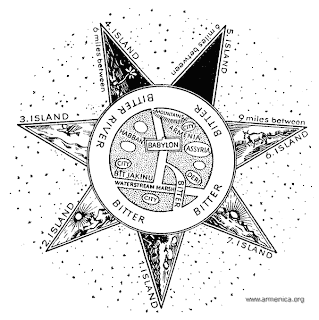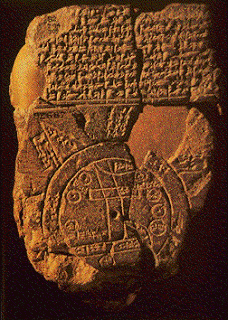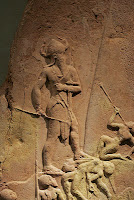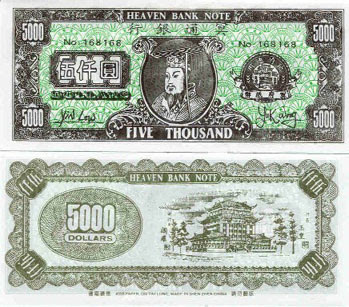Bison?
Continuing with the subject of maps, I wondered where the Sumerians actually imagined the underworld or netherworld, to be?
Is there in Sumerian texts any reference to a physical location, an entrance perhaps to the netherworld and where on the map should it be placed?
In the story known as The descent of Inana, the queen of heaven simply sets off and walks to the seven gates of Ganzer.
But the myth most often used as *the* guide book to the Sumerian netherworld, is the story known as Gilgamesh, Enkidu and the nether world.
The beginning of the the tale contains the reference to Ereshkigal given as a gift to the netherworld and to Enki setting out to save her, before getting into the main narrative concerning Inana and the Halub tree:
The theme of the river as a force which carries away and leads to exile continues in Enlil and Ninlil:
Enlil was sent into exile and Ninlil follows him:
So we know that the river of the netherworld is the Id-kura: the river that pulls people from life into death. Id-Kura translates roughly as Id, River, with Kur, meaning underworld, and ra meaning flood.
But where is it on the map?
Is it beyond the mountains, or before?
The story returns to the subject of the netherworld when Gilgamesh loses his ellag and his ekidma.
The three little triangles are reminiscent of the triangles at the edge of the map -triangle islands, or rather mountains -the 'mountainous country', or 'abroad', ki-gal, 'the great place', edin, 'the steppe', arali, kur.nu.gi.
Many translations describe the netherworld as if it is like Cormac McCarthy's The Road.
Gilgamesh questions Enkidu:
This brings up the subject of translation, and how cultural biases and fashionable concepts seep into the stories and change their meanings. Unless one knows how to read Sumerian (and even though there are equivalents of the 'Rossetta stones' that enable Sumerian to be translated) no one speaks Sumerian; so it is going to be difficult to understand what was really meant. On the other hand, the story texts were probably sold as narrative outlines for a story teller to flesh out.
Translators are keeping to the spirit of the text as they add and subtract, conflate and guess.
So I was pulled away from my task -of locating the netherworld- when I came across the word bison.
Is there a good reason for using the word bison in translation of a Sumerian poem?
I was trying to track down where Damuzi went. This poem is in Treasures of Darkness: A History of Mesopotamian Religion by Thorkild Jacobsen.
It is Sumerian, written around c.1700 B.C.
There are two words translators translate into bison: the Sumerian "gud-alim" and the Akkadian Kusarikku.
Going back to the clay tablet map, the description given at http://proteus.brown.edu/mesopotamianarchaeology/267 reads:
I can see that I need to learn Sumerian.
Is there in Sumerian texts any reference to a physical location, an entrance perhaps to the netherworld and where on the map should it be placed?
In the story known as The descent of Inana, the queen of heaven simply sets off and walks to the seven gates of Ganzer.
But the myth most often used as *the* guide book to the Sumerian netherworld, is the story known as Gilgamesh, Enkidu and the nether world.
The beginning of the the tale contains the reference to Ereshkigal given as a gift to the netherworld and to Enki setting out to save her, before getting into the main narrative concerning Inana and the Halub tree:
In those days, in those distant days, in those nights, in those remote nights, in those years, in those distant years; in days of yore, when the necessary things had been brought into manifest existence, in days of yore, when the necessary things had been for the first time properly cared for, when bread had been tasted for the first time in the shrines of the Land, when the ovens of the Land had been made to work, when the heavens had been separated from the earth, when the earth had been delimited from the heavens, when the fame of mankind had been established, when An had taken the heavens for himself, when Enlil had taken the earth for himself, when the nether world had been given to Erec-kigala as a gift; when he set sail, when he set sail, when the father set sail for the nether world, when Enki set sail for the nether world -- against the king a storm of small hailstones arose, against Enki a storm of large hailstones arose. The small ones were light hammers, the large ones were like stones from catapults (?). The keel of Enki's little boat was trembling as if it were being butted by turtles, the waves at the bow of the boat rose to devour the king like wolves and the waves at the stern of the boat were attacking Enki like a lion.Enki it seems, takes the boat but unfortunately the story does not tell what happens next on his journey.
The theme of the river as a force which carries away and leads to exile continues in Enlil and Ninlil:
At that time the maiden was advised by her own mother, Ninlil was advised by Nun-bar-ce-gunu: "The river is holy, woman! The river is holy -- don't bathe in it! Ninlil, don't walk along the bank of the Id-nunbir-tum! His eye is bright, the lord's eye is bright, he will look at you! The Great Mountain, Father Enlil -- his eye is bright, he will look at you! The shepherd who decides all destinies -- his eye is bright, he will look at you! Straight away he will want to have intercourse, he will want to kiss! He will be happy to pour lusty semen into the womb, and then he will leave you to it!"The inevitable happens.
Enlil was sent into exile and Ninlil follows him:
As Enlil was going about in the Ki-ur, the fifty great gods and the seven gods who decide destinies had Enlil arrested in the Ki-ur. Enlil, the ritually impure, left the city. Nunamnir, the ritually impure, left the city. (2 mss. have instead: "Enlil, ritually impure, leave the city! Nunamnir, ritually impure, leave the city!") Enlil, in accordance with what had been decided, Nunamnir, in accordance with what had been decided, Enlil went. Ninlil followed. Nunamnir went, the maiden chased him.
Enlil went. Ninlil followed. Nunamnir went, the maiden chased him. Enlil approached the man of the Id-kura river of the underworld, the man-eating river.
So we know that the river of the netherworld is the Id-kura: the river that pulls people from life into death. Id-Kura translates roughly as Id, River, with Kur, meaning underworld, and ra meaning flood.
But where is it on the map?
Is it beyond the mountains, or before?
The story returns to the subject of the netherworld when Gilgamesh loses his ellag and his ekidma.
"The widows 'accusation and the young girls' complaint caused them to fall down to the bottom of the netherworld".Brave Enkidu says that he will go down to fetch the -so far untranslated- objects.
"Enkidu went down to retrieve them but the nether world has seized him. Namtar did not seize him, the Asag did not seize him; but the nether world has seized him. The udug demon of Nergal, who spares nobody, did not seize him, but the nether world has seized him. He did not fall in battle on the field of manhood, but the netherworld has seized him."The entrance to the netherworld is the grave, but just going under ground seems dangerous and rivers too will attack and lead one to the netherworld -which is denoted by the three triangle symbol of the kur.
The three little triangles are reminiscent of the triangles at the edge of the map -triangle islands, or rather mountains -the 'mountainous country', or 'abroad', ki-gal, 'the great place', edin, 'the steppe', arali, kur.nu.gi.
Many translations describe the netherworld as if it is like Cormac McCarthy's The Road.
"He walked out in the grey light and stood and he saw for a brief moment the absolute truth of the world. The cold relentless circling of the intestate Earth. Darkness implacable. The blind dogs of the sun in their running. The crushing black vacuum of the universe. And somewhere two hunted animals trembling like ground foxes in their cover. Borrowed time and borrowed world and borrowed eyes with which to sorrow it."It is usually described as a place of dust and the dead seem to be almost bird-like, covered in feathers, waiting to fall apart, the zombie realm. But when Gilgamesh asks Enkidu about the netherworld the message is, in contrast to religions that seem to hate the material world that as long as a person has lived their life to the full and has family to take care of the grave, the underworld may not be too bad.
Gilgamesh questions Enkidu:
Did you see him who had one son?"
"I saw him."
"How does he fare?"
"He weeps bitterly at the wooden peg which was driven into his wall."
"Did you see him who had two sons?"
"I saw him."
"How does he fare?"
"He sits on a couple of bricks, eating bread."
"Did you see him who had three sons?"
"I saw him."
"How does he fare?"
"He drinks water from a saddle waterskin."
"Did you see him who had four sons?"
"I saw him."
"How does he fare?"
"His heart rejoices like a man who has four asses to yoke."
"Did you see him who had five sons?"
"I saw him."
"How does he fare?"
"Like a good scribe he is indefatigable, he enters the palace easily."
"Did you see him who had six sons?"
"I saw him."
"How does he fare?"
"He is a cheerful as a ploughman."
"Did you see him who had seven sons?"
"I saw him."
"How does he fare?" "As a companion of the gods, he sits on a throne and listens to judgments."
This brings up the subject of translation, and how cultural biases and fashionable concepts seep into the stories and change their meanings. Unless one knows how to read Sumerian (and even though there are equivalents of the 'Rossetta stones' that enable Sumerian to be translated) no one speaks Sumerian; so it is going to be difficult to understand what was really meant. On the other hand, the story texts were probably sold as narrative outlines for a story teller to flesh out.
Translators are keeping to the spirit of the text as they add and subtract, conflate and guess.
So I was pulled away from my task -of locating the netherworld- when I came across the word bison.
Is there a good reason for using the word bison in translation of a Sumerian poem?
I was trying to track down where Damuzi went. This poem is in Treasures of Darkness: A History of Mesopotamian Religion by Thorkild Jacobsen.
It is Sumerian, written around c.1700 B.C.
The wild bull, who has lain down, lives no more,
The wild bull, who has lain down, lives no more,
Dumuzi, The wild bull, who has lain down, lives no more,
The wild bull, who has lain down, lives no more.
O you wild bull, how fast you sleep!
How fast sleep ewe and lamb!
O you wild bull, how fast you sleep!
How fast sleep goat and kid!
I will ask the hills and the valleys,
I will ask the hills of the Bison:
"Where is the young man, my husband?"
I will say,
"He whom I no longer serve food"
I will say,
"He whom I no longer give to drink"
I will say,
"And my lovely maids"
I will say,
"And my lovely young men?"
"The Bison has taken thy husband away,
up into the mountains!"
"The Bison has taken thy young man away,
up into the mountains!"
"Bison of the mountains, with the mottled eyes!
Bison of the mountains, with the crushing teeth!
Bison! - He sleeps sweetly, he sleeps sweetly,
He whom I no longer serve food sleeps sweetly,
He whom I no longer give to drink sleeps sweetly,
My lovely maids sleep sweetly,
My lovely young men sleep sweetly!"
"My young man who perished from me
(at the hands of) your men,
"My young Ababa who perished from me
(at the hands of) your men,
Will never more calm me (with) his loving glance
Will never more unfasten his lovely bright clasp (at night)
On his couch you made the jackals lie down,
In my husband's fold you made the raven dwell,
His reed pipe - the wind plays it,
My husband's songs - the north wind sings them."
There are two words translators translate into bison: the Sumerian "gud-alim" and the Akkadian Kusarikku.
Going back to the clay tablet map, the description given at http://proteus.brown.edu/mesopotamianarchaeology/267 reads:
The so-called Babylonian map of the world. Clay tablet in British Museum Inv. 92687. Published by F.E. Peiser in Zeitschrift für Assyriologie und Vorderasiatische Archäologie 4 (1889) 361-370.
It is dated to the first half of the First Millennium BC.
The geographical knowledge of the Mesopotamian core territory is presented in a non-scalar graphic manner, with fair amount of accuracy, spotting certain regions and cities (some of which were labeled) around prominent mountains and rivers.
The visual representation of this geography uses a cursory but identifiable veracity, while the unknown edges of the inhabited world (dadmū) are geometricised in the pictorial representation and mytho-poeticized in its verbal ekphrasis.
The report of the fauna of the inhabited world in the text that accompanied the drawing, is specifically concerned with the content of the mythical marginal landscapes, the distant lands, listing those animals created by the god Marduk "on top of the sea".
The comprehensive list of the fauna comprises:
the anzû-bird,
the scorpion-man (girtablullû),
sea-serpent (mušhuššu),
gazelle (armu, ‹abītu),
zebu,
water-buffalo (apsasû),
panther (nimru),
bull-man (kusarikku),
lion (nēšu),
wolf (barbaru),
red-deer (lulīmu),
hyena (būsu),
male/female monkey (pagû/pagītu),
ibex (turāhu),
ostrich (lurmu),
cat (šurānu),
chameleon (hurbabillu).
The text presents a liminal knowledge of the fabulous landscapes in a mytho-poetic narrative of mapmaking. The major concern is not the obvious well-known landscape of Mesopotamia, but its fictitious periphery that needed to be presented.So contemporary translators use the word bison to mean far away, it becomes a word Kur, an ambiguous word...because bison are wild and far away to us?
I can see that I need to learn Sumerian.




